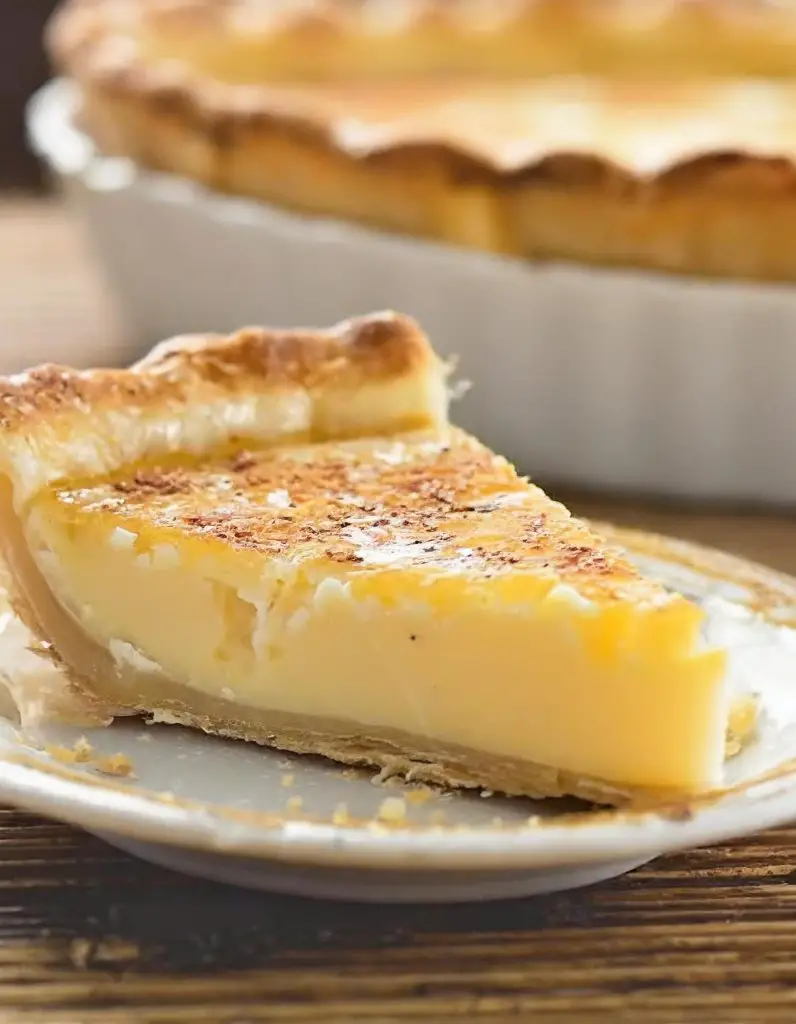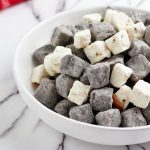I absolutely love making old-fashioned custard pie! It’s a timeless dessert that never fails to impress with its rich, creamy filling and buttery, flaky crust.

This recipe is a perfect blend of simple ingredients like eggs, sugar, vanilla, and milk, creating a velvety smooth custard that just melts in your mouth with every bite. The pie is baked to a golden perfection, giving it a delicate caramelized top that adds a hint of sweetness. Served either warm or chilled, this custard pie is a classic treat that evokes nostalgia and comfort with every delicious slice.
Ingredients Needed for This Recipe
- 1 disc of Foolproof Flaky Pie Dough or a good quality store-bought pie dough
- 4 large eggs
- ½ cup sugar (increase to ⅔ for a sweeter pie)
- ½ teaspoon salt
- 1 tablespoon vanilla extract
- 1 cup heavy cream
- 1 ½ cups milk
- ¼ teaspoon freshly grated nutmeg
- Fresh whipped cream for serving
Step-by-step instructions to make the pie
- Preheat the Oven: Preheat the oven to 425 degrees F.
- Prepare the Pie Dough: Dust a rolling pin with flour and roll out the pie dough so that it’s about 3 inches larger than your pie plate. Trim the edges to make it round, if necessary. Gently roll the dough onto the rolling pin and transfer it to the pie plate. Press it in to fit, tuck the loose pieces under, and crimp the edges. Place in the freezer for at least 15 minutes.
- Prepare the Pie Crust: Crack the eggs into a medium bowl. Remove the pie crust from the freezer, brush it with egg whites to create a barrier and prevent sogginess. Bake the crust for 10 minutes, then let it cool.
- Lower Oven Temperature: Lower the oven temperature to 325 degrees F.
- Make the Custard: Add sugar, salt, vanilla extract, heavy cream, milk, and nutmeg to the eggs. Whisk together until well combined, avoiding too much air.
- Bake the Pie: Place the pie plate on a foil-lined sheet pan. Pour the mixture into the cooled crust. Bake for about 1 hour or until the edges are set but the center is slightly wobbly.
- Cool and Serve: Allow the pie to cool to room temperature, then refrigerate until ready to serve. Serve chilled, topped with whipped cream and more grated nutmeg, if desired.
Tips for Perfecting the Recipe
Choose Quality Ingredients: The simplicity of a custard pie means each ingredient shines through. Use the freshest eggs, high-quality vanilla extract, and the best dairy you can find. The flavor of the custard will reflect the quality of the ingredients used.
Pie Dough Perfection: Whether you’re making your pie dough from scratch or using store-bought, ensure it’s rolled out evenly to prevent a soggy bottom. If you’re making homemade dough, keep everything as cold as possible to achieve a flaky crust.
Temperature Matters: Ingredients should be at room temperature to mix more thoroughly and bake more evenly. Cold ingredients can lead to a lumpy custard.
Avoid Overmixing: When combining your custard ingredients, mix just until the eggs, sugar, and dairy are blended. Overmixing can incorporate too much air, leading to an undesirable texture.
Baking the Pie: Pre-baking or blind baking the crust is crucial to prevent it from becoming soggy once the custard is added. Additionally, baking the pie at a high temperature initially, then lowering it, helps set the custard perfectly without overcooking.
The Jiggle Test: The pie is done when the edges are set, but there’s a slight jiggle in the center. This indicates a silky, smooth custard inside. Overbaking can lead to a rubbery texture.
Cooling and Chilling: Allow the pie to cool gradually at room temperature before chilling it in the refrigerator. This slow cooling process helps prevent cracks from forming on the surface.
Serving Suggestions
Classic Whipped Cream: A dollop of freshly whipped cream on top of each slice adds a light, creamy texture that complements the dense custard. Consider flavoring the whipped cream with a bit of vanilla or bourbon for an extra touch.
Fruit Compotes and Fresh Berries: The richness of custard pie pairs beautifully with the tartness of fruit. Serve with a berry compote or fresh berries for a refreshing contrast.
Nutmeg and Cinnamon: A light dusting of freshly grated nutmeg or cinnamon on top of the pie or the whipped cream can enhance the warm flavors of the custard.
Coffee or Tea: Serve your custard pie with a hot cup of coffee or tea. The bitterness of coffee or the subtle flavors of tea make a great pairing with the sweet, creamy pie.
Dessert Wines: For an elegant dessert course, pair your custard pie with a sweet dessert wine such as a Sauternes or a Moscato. The wine’s sweetness and body can complement the creamy texture and flavors of the pie.
Storage Tips
Refrigeration is Key: Custard pie must be refrigerated. Once cooled to room temperature, cover the pie loosely with plastic wrap or aluminum foil and refrigerate. This will keep the custard from spoiling and the crust from becoming too soft.
Avoid Freezing: Freezing custard pies is not recommended as it can cause the custard to separate and the crust to become soggy upon thawing.
Shelf Life: Properly stored in the refrigerator, custard pie will last for up to 4 days. Be mindful of any signs of spoilage, such as an off smell or taste, before consuming.
Serving After Storage: When ready to serve again, you might want to refresh the pie by letting it sit at room temperature for 10-15 minutes. This can help improve the texture and flavor, making it more enjoyable.
Frequently Asked Questions
Can I use a store-bought crust? Yes, a store-bought crust can work well for those looking to save time. Just ensure it’s of good quality and pre-bake it according to the package instructions for the best results.
How do I prevent my custard from being runny? A runny custard can result from underbaking or too much liquid in the filling. Ensure you bake the pie until the edges are set but the center slightly jiggles, and measure your ingredients accurately.
Can I make this pie ahead of time? Yes, custard pie can be made a day ahead. Just complete the baking and cooling process, then cover and refrigerate until ready to serve. This can actually improve the flavor and texture as the pie sets.
Why did my custard pie crack? Cracks can occur if the pie is overbaked or cools too quickly. To prevent cracks, bake just until set and allow the pie to cool gradually in a draft-free area.
Can I add flavors to my custard pie? Absolutely! While nutmeg is traditional, feel free to experiment with cinnamon, cardamom, or even citrus zest to add a unique twist to your pie.
Is it necessary to strain the custard mixture? Straining the custard mixture can remove any bits of egg or impurities, resulting in a smoother filling. While not strictly necessary, it’s a recommended step for those seeking a refined texture.
How do I know when the pie crust is properly pre-baked? The crust should be lightly golden and feel dry to the touch. If using pie weights or dried beans, remove them in the last few minutes of baking to allow the bottom to brown slightly.

Old Fashioned Custard Pie
INGREDIENTS
- 1 disc of Foolproof Flaky Pie Dough or a good quality store-bought pie dough
- 4 large eggs
- ½ cup sugar increase to ⅔ for a sweeter pie
- ½ teaspoon salt
- 1 tablespoon vanilla extract
- 1 cup heavy cream
- 1 ½ cups milk
- ¼ teaspoon freshly grated nutmeg
- Fresh whipped cream for serving
INSTRUCTIONS
- Preheat the Oven: Preheat the oven to 425 degrees F.
- Prepare the Pie Dough: Dust a rolling pin with flour and roll out the pie dough so that it’s about 3 inches larger than your pie plate. Trim the edges to make it round, if necessary. Gently roll the dough onto the rolling pin and transfer it to the pie plate. Press it in to fit, tuck the loose pieces under, and crimp the edges. Place in the freezer for at least 15 minutes.
- Prepare the Pie Crust: Crack the eggs into a medium bowl. Remove the pie crust from the freezer, brush it with egg whites to create a barrier and prevent sogginess. Bake the crust for 10 minutes, then let it cool.
- Lower Oven Temperature: Lower the oven temperature to 325 degrees F.
- Make the Custard: Add sugar, salt, vanilla extract, heavy cream, milk, and nutmeg to the eggs. Whisk together until well combined, avoiding too much air.
- Bake the Pie: Place the pie plate on a foil-lined sheet pan. Pour the mixture into the cooled crust. Bake for about 1 hour or until the edges are set but the center is slightly wobbly.
- Cool and Serve: Allow the pie to cool to room temperature, then refrigerate until ready to serve. Serve chilled, topped with whipped cream and more grated nutmeg, if desired.
Notes
- Keep the raw pie crust in the freezer until ready to bake for a flaky texture.
- Do not over whisk the custard to avoid air bubbles.
- Pour the custard into the crust close to the oven to minimize spills.
- Strain the custard for extra smoothness, if desired.
- Ensure the pie crust has cooled completely before adding the custard.
- Cover the edges with foil if they brown too quickly.
- Do not overbake to maintain a creamy texture.
- Chill the custard pie before serving to let it set properly.




